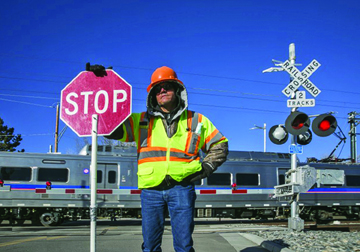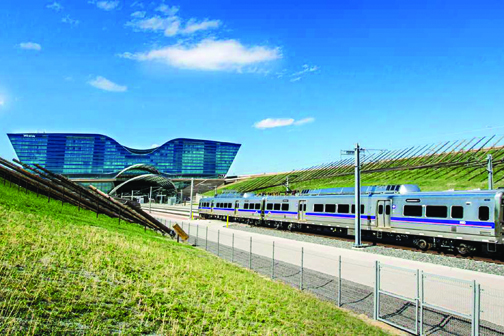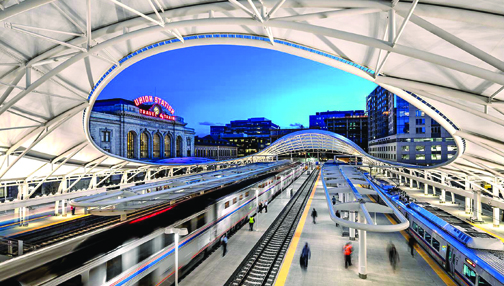Travel Times Are Longer Than The Same Trip By Bus; Usually Uber, Lyft, Bike, Scooter And An App Are Faster
by Glen Richardson

Train To Plane Pain: The 22.8-mile spur from downtown to DIA was expected to speed regional airport travel. Plagued by software problems, however, flaggers keep returning to crossings along the A Line between Union Station and DIA.
Tracking Trouble: As train problems increased RTD has resorted to flying drones to keep light rail systems in reliable motion. The aerial machines monitor the conditions of rail tracks and alignments.
“Less traffic congestion and more commuting options will improve the region’s quality of life and make Denver that much more attractive to residents and businesses,” declared then RTD Chief Cal Marsella at Rapid Transit’s 2006 launch.
Denver’s light rails trains, however, keep getting off track or making switchbacks — train lingo for reversing directions.
In the dozen years since Denver sent its neighborhoods down the transit tracks, the endless headlines haven’t been affable. Consider just a few from the last 10 months:
- Disruptions Delay Airport Travel – Feb.;
- Two Men Rob, Fatally Shoot Man At RTD Rail Station – March;
- The A Line Stuck For Hours Friday – April;
- Riders On Several Denver Light Rail Routes Run Into Long Delays – Aug.;
- RTD To Close 4 Downtown Light Rail Lines For 10 Days – Sept.; and
- Pedestrian Hit By Train In The Baker Neighborhood Has Died – Oct.
Rail Squeal
The speed myth is that rail transit is rapid transit. When the time needed for station access, transfer, waiting, and delays are taken into account, local riders insinuate that by and large, “rail travel times are longer than the time required for the same trip by bus.”
Moreover, business travelers are discovering the same thing: “Overall, not a bad ride,” declared Phil, a New York businessman. But he’s quick to add, “If you are not in a rush and know where you are going. Yet, I coughed up the cash for a taxi to bring me back to my hotel as it was way quicker and more convenient since I had a flight to catch.”
In addition to the speed concern, light rail ridership is increasingly being tied to competing alternatives. “If you have a car, a bike or a scooter on an app in your hand, and it’s right there, why not use that?” asks Jeff, who admits to being an area yuppie. His point: “You don’t have the indignity of being stuck at an RTD Park-N-Ride or on the side of the road for a bus that never comes.”
Riders Slump, Rates Jump
RTD’s rail service in Denver includes eight light rail lines plus two commuter rail lines. Light rail serves downtown Denver from the west (W Line), southwest (C and D Lines, along US 85), and southeast (E, F, and H Lines, along the I-25 corridor). Most light rail lines operate every 15 minutes or less throughout the day, including evenings and weekends. Light rail lines serve either Union Station or 16th & California-Stout Stations at either end of downtown Denver.
Transit ridership fell in 31 of 35 major metropolitan areas in the U.S. last year, including less than expected in Denver. As ridership slumps, rates will jump in Denver. With fewer riders than expected, RTD is raising the rates charged passengers effective January 1. A one-way ride from DIA on the A Line jumps from $9 to $10.50. Local fares increase to $3, up 40-cents and regional fares go up 75-cents to $5.25.
Denver averaged 67,500 weekday boardings last year, ranking the city seventh behind both Portland and San Diego. As a contrast reference, San Francisco’s Embarcadero averages 162,500-weekday boardings.
Commuter Rail Venture
The A and B Lines along with the G Line when it eventually opens, are RTD’s first foray in commuter rail. The trains are much heavier and go faster than the agency’s light rail — up to 79 mph. The lines are being built and operated by a private consortium known as Denver Transit Operators. The Transit Operators and their subcontractors are all under contract to RTD.
RTD has trumpeted the A and B Lines for being the first commuter rail lines in the country to integrate a PTC system (Positive Train Control) into its construction. The system, however, has had a shaky start, including with the PTC-controlled wireless crossing gates that have constantly led to flaggers being stationed at grade crossings. Insinuations have been made that the malfunctioning PTC system may be due to a bad design of the A Line itself.
The Federal Railroad Administration (FRA) requires a minimum warning time of 20 seconds before a train enters the crossing. The A Line timi ng is often a great deal beyond the requirement. This is the foremost reason why the planned RTD G Line is delayed.
ng is often a great deal beyond the requirement. This is the foremost reason why the planned RTD G Line is delayed.
Delays, Lawsuit
Metro leaders in Denver’s north and western suburbs have constantly complained because of the delays associated with the rail lines promised in the 2005 FasTracks vote. RTD initially set an opening of this year (2018) when construction began on the North line four years ago. The 13-mile line will carry passengers between Northglenn and downtown’s Union Station.
RTD now estimates its future northern suburb commuter rail line won’t open until the spring of 2020, a delay of approximately six months beyond the estimate made last year of late 2019. Northglenn’s Mayor Carol Dodge isn’t surprised by the most recent delay. “We figured it was going to be 2020, because they really haven’t kept their promises on many of the openings.”
Delays and other problems with Denver’s A Line have resulted in a September lawsuit against RTD by Denver Transit Partners. The suit accuses RTD of “breach of contract, violation of the covenant of good faith and fair dealing” and seeks “declaratory relief against the district’s refusal to accept changes in law and unforeseeable circumstances,” according to Waukesha, Wis.-based Trains Magazine. The magazine article quotes The Denver Post as saying the group of private companies are suing RTD for “tens of millions of dollars.”
Management Matters
Critics suggest many of RTD’s problems are a result of “train operations and management.” They related Denver’s problem to the procedures and related equipment enabling a coherent operation of the different structural subsystem, both during normal and degraded operation. In particular they refer to train driving, traffic planning and management.
In March CPR News reported incidents of speeding, blown red signals and even derailments in the maintenance yard. Interviews by CPR’s Nathaniel Minor with former and current engineers cited “a constant push to remain on time, tired operators and low wages that contribute to high employee turnover and, subsequently inexperienced engineers.”
The broadcast came shortly after RTD named Michael Ford its new chief operating officer in February. In the new position created by the agency, Ford is to “work with train operators, mechanics, and support staff to ensure the agency’s operations are reliable, safe and clean.”
Beauty & The Beast: Denver’s Union Station is an architectural marvel. All RTD needs to do now is solve its operational issues and get trains operating on time without delays.

